The Queen's College, Oxford
| The Queen's College | |||||||||||||
|---|---|---|---|---|---|---|---|---|---|---|---|---|---|
| Oxford | |||||||||||||
 | |||||||||||||
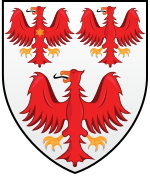 Blazon: Argent, three eagles displayed gules, beaked and legged or, on the breast of the first, a mullet of six points of the last. | |||||||||||||
| Location | High Street, Oxford | ||||||||||||
| Coordinates | 51°45′11″N 1°15′04″W / 51.753187°N 1.251043°W / 51.753187; -1.251043Coordinates: 51°45′11″N 1°15′04″W / 51.753187°N 1.251043°W / 51.753187; -1.251043 | ||||||||||||
| Full name | The Queen's College in the University of Oxford | ||||||||||||
| Latin name | Collegium Reginae | ||||||||||||
| Established | 1341 (1341) | ||||||||||||
| Named for | Philippa of Hainault | ||||||||||||
| Sister college | Pembroke College, Cambridge | ||||||||||||
| Provost | Paul Madden | ||||||||||||
| Undergraduates | 349[1] (2011/2012) | ||||||||||||
| Postgraduates | 133 | ||||||||||||
| Website | www.queens.ox.ac.uk | ||||||||||||
| Boat club | [1] | ||||||||||||
| Map | |||||||||||||
 Location in Oxford city centre | |||||||||||||
The Queen's College is a constituent college of the University of Oxford, England. The college was founded in 1341 by Robert de Eglesfield (d'Eglesfield) in honour of Queen Philippa of Hainault (wife of King Edward III of England). It is distinguished by its predominantly neoclassical architecture, which includes buildings designed by Sir Christopher Wren and Nicholas Hawksmoor.
In 2015, the college had an endowment of £265 million,[2] making it the fifth-wealthiest college (after St. John's, Christ Church, All Souls and Merton).[3]
Contents
1 History
1.1 Naming
1.2 In popular culture
1.3 Traditions
2 Buildings
2.1 Front Quad
2.2 Chapel
2.3 Back Quad
2.4 Library
2.5 Annexes
2.6 Gallery
3 Student life
3.1 Sport
3.2 Music
3.3 College Grace
4 Notable former students
5 See also
6 References
7 External links
History

Statue of Robert de Eglesfield in the Provost's garden
The college was founded in 1341 as "Hall of the Queen's scholars of Oxford" by Robert de Eglesfield (d'Eglesfield), chaplain to Queen Philippa of Hainault (the wife of King Edward III of England), after whom the hall was named. Robert's aim was to provide clergymen for his native Cumberland and where he lived in Westmorland (both part of modern Cumbria). In addition, the college was to provide charity for the poor. The college's coat of arms is that of the founder; it differs slightly from his family's coat of arms, which did not include the gold star on the breast of the first eagle. The current coat of arms was adopted by d'Eglesfield because he was unable to use his family's arms, being the younger son. d'Eglesfield had grand plans for the college, with a provost, twelve fellows studying theology, up to thirteen chaplains, and seventy-two poor boys. However, the college did not have the funding to support such numbers, and initially had just two fellows.
The college gained land and patronage in the mid-15th century, giving it a good endowment and allowing it to expand to 10 fellows by the end of the century. By 1500, the college had started to take paying undergraduates, typically sons of the gentry and middle class, who paid the fellows for teaching. There were 14 of these in 1535; by 1612, this had risen to 194. The college added lectureships in Greek and philosophy. Provost Henry Robinson obtained an Act of Parliament incorporating the college as 'The Queen's College' in 1585, so Robinson is known as the second founder.
Following the new foundation, the college had a good reputation and flourished until the 1750s. Joseph Williamson, who had been admitted as a poor boy and went on to become a fellow, rose to Secretary of State and amassed a fortune. He funded a new range on Queen's Lane built in 1671–72. Following a bequest of books from Thomas Barlow, a new library was built between 1693 and 1696 by master builder John Townesend. A further bequest from Williamson of £6,000, along with purchase of the buildings along the High Street, allowed a new front quad to be built and for the remaining medieval buildings to be replaced. This was completed by 1759 by John's son William Townesend.[4][5] The college gained a large number of benefactions during this time, which helped to pay for the buildings and bring in more scholars from other, mostly northern, towns.
From the 1750s, as with other Oxford colleges, standards dropped. The Oxford commission of 1850–1859 revised the statues and removed the northern preference for fellows and most of the students. Over the coming years, requirements for fellows to be unmarried were relaxed, the number of fellows required to have taken orders and studied theology was reduced, and in 1871 the Universities Tests Act allowed non-conformists and Catholics.[6]
Like many of Oxford's colleges, Queen's admitted its first mixed-sex cohort in 1979, after more than six centuries as an institution for men only.[citation needed]
Naming
The college is named for its first patroness, Queen Philippa of Hainault (1314–1369, the wife of King Edward III). Established in January 1341 'under the name of the Hall of the Queen's scholars of Oxford' (sub nomine aule scholarium Regine de Oxon), the college was subsequently called the 'Queen's Hall', 'Queenhall' and 'Queen's College'. An Act of 1585 sought to end this confusion by providing that it should be called by the one name 'the Queen's College';[7] in practice the definite article is usually omitted. The full name of the College, as indicated in its annual reports, is The Provost and Scholars of The Queen’s College in the University of Oxford.[8]Queens' College in Cambridge positions its apostrophe differently and has no article, as it was named for multiple Queens (Margaret of Anjou, the wife of King Henry VI, and Elizabeth Woodville, the wife of King Edward IV).
In popular culture
In April 2012, as part of the celebrations of the Diamond Jubilee of Elizabeth II, a series of commemorative stamps was released featuring A-Z pictures of famous British landmarks. The Queen's College's front quad was used on the Q stamp, alongside other landmarks such as the Angel of the North on A and the Old Bailey on O.[9]
Traditions
One of the most famous feasts of the College is the Boar's Head Gaudy, which originally was the Christmas dinner for members of the College who were unable to return home to the north of England over the Christmas break between terms, but is now a feast for old members of the College on the Saturday before Christmas.
Buildings

The main quad of Queen's
Front Quad
The main entrance on the High Street leads to the front quad, which was built between 1709 and 1759. There are symmetrical ranges on the east and west sides, while at the back of the quad is a building containing the chapel and the hall.[5]Nicholas Hawksmoor provided a number of designs that were not used directly but that heavily influenced the final design. Above the college entrance is a statue of Caroline of Ansbach (wife of George II) by the sculptor Henry Cheere; the legend 'Carolina Regina, Nov. 12, 1733' may be found marking the laying of the foundation stone of the screen wall, which is visible from the High Street.[5]

The Chapel of The Queen's College, Oxford. Looking west towards the Frobenius organ
Chapel
The chapel is noted for its Frobenius organ in the west gallery. It was installed in 1965, replacing a Rushworth and Dreaper organ from 1931. The earliest mention of an organ is 1826. The Chapel Choir has been described as "Oxford's finest mixed-voice choir" and continues to perform termly concerts, recent examples of which include Handel's Messiah and Bach's St John Passion.[10][11] The chapel has stood virtually unchanged since it was consecrated by the Archbishop of York in 1719.
Holy Communion is celebrated every Sunday morning and at other times, and is open to all communicant members of any Christian church or denomination. The Sunday evening service takes the traditional form of Choral Evensong, which is also held on Wednesday and Friday evenings during term. Morning and evening prayer is said daily, and at other times some like to use the stillness for their own prayer. Baptisms, confirmations, and weddings are also conducted for members or former members of the College.
Back Quad
A second and older quad lies to the north of the hall and chapel. The west side consists of the library. The east side is the Williamson building, which was originally built to a design by Christopher Wren but has been largely rebuilt since then.[5]
Library
The Upper Library has been a focal point for the College ever since its construction at the end of the 17th century. Unlike many other similar rooms in Oxford libraries, the Upper Library remains as a silent reading room for students open during staffed hours.[12] The open cloister below the Upper Library was enclosed in the 19th century to form the Lower Library, which now houses the bulk of the lending collection. The lending collection consists of around 50,000[13] with an additional 70,000 items in the special collections available by appointment.[14] In April 2017 the New Library opened[15] beneath the Provost's Garden.[16]
Annexes
Queen's is able to provide accommodation for all of its undergraduates, who are divided between the college's main buildings and annexes nearby. These include the Florey Building in St Clement's, designed by James Stirling and named after former Queen's Provost and Nobel Prize winner Howard Florey, which houses most of the college's first years.[17] It contains nearly 80 rooms; those on the top floor have a mezzanine level where the students' beds are located. At one end of the building at ground level there is a common room and a breakfast room. The college also owns the Cardo Building opposite the Oxford University Sports centre on Iffley Road (where Roger Bannister ran the first ever four-minute mile in 1954). This building is home to a mixture of first, second and third years, as well as a common room, breakfast room and the college's two squash courts. Adjacent to college is the other main undergraduate annexe, located just across Queen's Lane, called Carrodus Quad. It has been completely refurbished, and now has approximately 80 en-suite rooms for second- and final-year students. The building also houses a conference room, one of the college's music practice rooms and the college gym. Many of the post-graduates are housed in another college annexe, St Aldate's House, which is situated down St Aldate's near Folly Bridge. A small number of undergraduates (particularly international students) also live in the building. Each room has its own en suite and a kitchen shared with up to nine other students.
Gallery
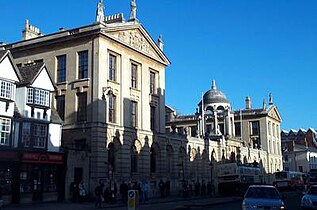

The Queens College, detail
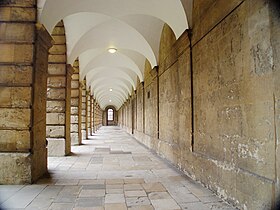
The Queens College

The Queens College, detail
Student life

High Street entrance to Queen's College from the main quad.
Queen's is an active community performing strongly in intercollegiate sport competitions, having a variety of societies and, as one of the larger colleges, hosting triennial Commemoration balls. The 2007 ball coincided with the 666th anniversary of the college.[18]
Queen's is host to a number of dining, drinking and sports societies, as well as some which are more academically orientated such as a medical society.
Sport

Queen's College pavilion
The college playing field, less than a mile from the main buildings, runs down to the banks of the Isis. It has a football and a hockey pitch, together with hard tennis courts, a netball court and a pavilion. The football ground is nicknamed Fortress Riverside by the club and its supporters, owing to its close proximity to the Isis. Queen's College shares a rugby pitch nearby with University College. In the summer, the goalposts go down and a cricket square appears in the middle.
On the opposite bank of the river is a boathouse, shared with two other colleges. The college's two squash courts, located at the Cardo Building. The college has a designated table tennis room.
College sport is organised and funded through the Amalgamated Sports Clubs Committee, consisting of individual club captains and other representatives of college sport.[19] The Queen's College competes strongly in most of the intercollegiate Cuppers (tournament style) and league sports, with many 1st teams competing in top divisions.
The College is notable for having one of the oldest boat clubs in the world, along with many other colleges. In 1837, The Queen's College Boat Club represented Oxford in the third Boat Race against Lady Margaret Boat Club, representing Cambridge, and won. This event, held on the River Thames at Henley-on-Thames, is credited with leading to support from the town for the establishment of the Henley Royal Regatta, one of the most famous rowing events in the world, in 1839.[citation needed] The college's colours were changed thereafter from red and white to navy blue and white, the colours of the university. Rowing is still a major sport in the College, with the second men's boat winning blades in Torpids 2015.
Music

The choir performing in the Front Quad on Ascension morning 2009.
The Queen's College is well known in and beyond Oxford for the quality and quantity of its musical activities. The mixed-voice Chapel Choir is conducted by the Organist and Praelector in Music, Owen Rees, a noted scholar of Iberian polyphony, and occasional services are conducted by the Organ Scholars. The singers include Choral Scholars (up to eighteen at any one time) and volunteers, all of whom are auditioned. The Choir sings Evensong three times a week during term, and performs one major concert each term, often with a noted orchestral ensemble; most recently, the choir performed Bach's St. John Passion in the Sheldonian Theatre. The choir also undertakes regular tours and short visits both within this country and abroad. The Eglesfield Musical Society, named after the Founder (and the oldest musical society in Oxford), organises a substantial series of concerts each year, ranging from chamber music to orchestral works. These concerts provide performing and conducting opportunities for the College's many musicians, as well as featuring visiting artists. There are weekly lunchtime organ recitals in College, including, during 2000, a series featuring the complete organ works of Bach, to mark the 250th anniversary of the composer's death.
College Grace
As is the case with many Oxbridge colleges, Queen's uses a Latin grace which is recited every evening before the second sitting of dinner:
Benedic nobis, Domine Deus, et his donis, quae ex liberalitate Tua sumpturi sumus; per Jesum Christum Dominum nostrum. Amen.
At gaudy dinners this grace is sung by the choir.
Notable former students

Henry V

John Wycliffe

Thomas Middleton

John Owen
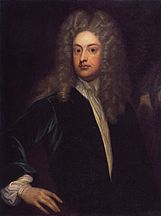
Joseph Addison

Edmund Halley
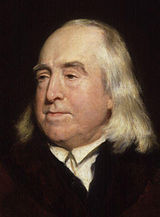
Jeremy Bentham
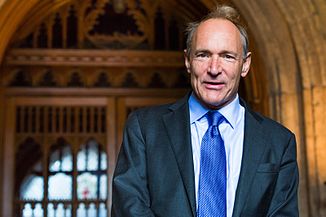
Tim Berners-Lee

Edwin Hubble

Walter Pater

Ernest Dowson

Vere Gordon Childe
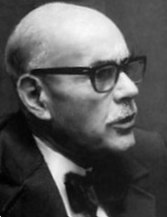
Wilfred Bion

Rowan Atkinson

Tony Abbott

Brian Paddick

Eric Garcetti
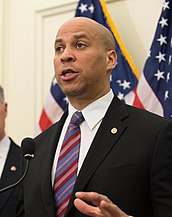
Cory Booker
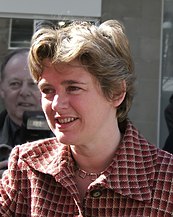
Ruth Kelly
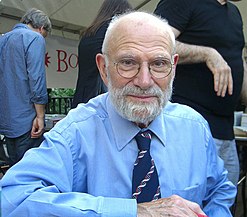
Oliver Sacks
Tony Abbott, 28th Prime Minister of Australia
Joseph Addison, co-founder of The Spectator
Rowan Atkinson, actor and comedian, known for Blackadder and Mr. Bean
Jeremy Bentham, English philosopher, and legal and social reformer
Tim Berners-Lee, inventor of the World Wide Web and director of the World Wide Web Consortium
Wilfred Bion, British psychoanalyst[20]
Christopher Bland, British businessman and politician
Cory Booker, United States Senator from New Jersey
Vere Gordon Childe, Australian archaeologist
John Crewdson, Pulitzer Prize-winning journalist for The New York Times
Ernest Dowson, English poet and prose writer
Alfred Enoch, British actor
Eric Garcetti, Mayor of Los Angeles
Leonard Hoffmann, Baron Hoffmann, English jurist and judge
Edmund Halley, English astronomer
Fred Halliday, Irish academic, Fellow of the British Academy, Montague Burton Professor of International Relations at London School of Economics- King Henry V of England
Edwin Powell Hubble, American astronomer[21]
Ruth Kelly, former UK Cabinet and Government Minister
Kenneth Leighton, twentieth-century English composer
Thomas Middleton, English Jacobean playwright and poet
David Oliver, Geriatrician. Professor of Medicine for Older People at City University. Former National Clinical Director for Older People Department of Health. President British Geriatrics Society. Visiting Fellow The King's Fund
John Owen, seventeenth-century English theologian
Brian Paddick, twice Liberal Democrat candidate for Mayor of London
Walter Horatio Pater, English essayist
Richard Rampton, barrister in high-profile cases such as Irving v Penguin Books and Lipstadt, which was the subject of the film Denial
Ryan Max Riley, United States Ski Team skier
Oliver Sacks, neurologist and writer
Leopold Stokowski, conductor
Claire Taylor MBE, English cricketer
William Thomson, Archbishop of York
John Wycliffe, English theologian
Adam Zamoyski, historian and author
See also
- Fellows of The Queen's College, Oxford
- List of Provosts of The Queen's College, Oxford
- Queens' College, Cambridge
Daniel Faraday and The Constant in Lost- List of Honorary Fellows of The Queen's College, Oxford
- The Neda Agha-Soltan Graduate Scholarship
References
^ "Undergraduate numbers by college 2011–12". University of Oxford..mw-parser-output cite.citationfont-style:inherit.mw-parser-output .citation qquotes:"""""""'""'".mw-parser-output .citation .cs1-lock-free abackground:url("//upload.wikimedia.org/wikipedia/commons/thumb/6/65/Lock-green.svg/9px-Lock-green.svg.png")no-repeat;background-position:right .1em center.mw-parser-output .citation .cs1-lock-limited a,.mw-parser-output .citation .cs1-lock-registration abackground:url("//upload.wikimedia.org/wikipedia/commons/thumb/d/d6/Lock-gray-alt-2.svg/9px-Lock-gray-alt-2.svg.png")no-repeat;background-position:right .1em center.mw-parser-output .citation .cs1-lock-subscription abackground:url("//upload.wikimedia.org/wikipedia/commons/thumb/a/aa/Lock-red-alt-2.svg/9px-Lock-red-alt-2.svg.png")no-repeat;background-position:right .1em center.mw-parser-output .cs1-subscription,.mw-parser-output .cs1-registrationcolor:#555.mw-parser-output .cs1-subscription span,.mw-parser-output .cs1-registration spanborder-bottom:1px dotted;cursor:help.mw-parser-output .cs1-ws-icon abackground:url("//upload.wikimedia.org/wikipedia/commons/thumb/4/4c/Wikisource-logo.svg/12px-Wikisource-logo.svg.png")no-repeat;background-position:right .1em center.mw-parser-output code.cs1-codecolor:inherit;background:inherit;border:inherit;padding:inherit.mw-parser-output .cs1-hidden-errordisplay:none;font-size:100%.mw-parser-output .cs1-visible-errorfont-size:100%.mw-parser-output .cs1-maintdisplay:none;color:#33aa33;margin-left:0.3em.mw-parser-output .cs1-subscription,.mw-parser-output .cs1-registration,.mw-parser-output .cs1-formatfont-size:95%.mw-parser-output .cs1-kern-left,.mw-parser-output .cs1-kern-wl-leftpadding-left:0.2em.mw-parser-output .cs1-kern-right,.mw-parser-output .cs1-kern-wl-rightpadding-right:0.2em
^ "Queen's Annual Report 2015 Public" (PDF).
^ "Annual Report and Financial Statements, 2014" (PDF). d307gmaoxpdmsg.cloudfront.net.
^ "The Queen's College, Oxford". www.queens.ox.ac.uk. Retrieved 2017-04-30.
^ abcd "Oxford's greatest neo-classical college is restored". Country Life. 2014-08-17. Retrieved 2017-04-30.
^ "The Queen's College | British History Online". www.british-history.ac.uk. Retrieved 2017-05-01.
^ A History of the County of Oxford: Volume 3: "The University of Oxford", 1954, p.132
^ Annual Report and Financial Statements, 2011 Archived 23 April 2012 at the Wayback Machine
^ "Royal Mail's first class portrait of Britain: From A to Z, stamps of landmarks worth writing home about". Mail Online. 9 April 2012.
^ "The Chapel Choir of The Queen's College Oxford". Guild Records page. Retrieved 27 April 2007.
^ "Archive". Choir of The Queen's College, Oxford.
^ "Opening Hours - The Queen's College". ox.ac.uk. Archived from the original on 12 March 2018.
^ "The Queen's College, Oxford". www.queens.ox.ac.uk. Retrieved 2017-04-30.
^ "The Queen's College, Oxford". www.queens.ox.ac.uk. Retrieved 2017-04-30.
^ "The Queen's College, Oxford". www.queens.ox.ac.uk. Retrieved 2017-04-30.
^ "The Queen's College, Oxford". www.queens.ox.ac.uk. Retrieved 2017-04-30.
^ "Accommodation - The Queen's College". ox.ac.uk. Archived from the original on 22 October 2013.
^ "Queen's College Ball". Retrieved 27 April 2007.
[permanent dead link]
^ The Queen's College, Oxford University. "The Queen's College". ox.ac.uk.
^ "Wilfred Bion - melanie klein trust". melanie-klein-trust.org.uk.
^ "Archived copy". Archived from the original on 26 July 2011. Retrieved 15 April 2011.CS1 maint: Archived copy as title (link) "For example, the Rhodes Scholar identifiers for Edwin Hubble (American astronomer for whom the Hubble Telescope is named) would be “Illinois & Queen’s 1910”."
External links
| Wikimedia Commons has media related to The Queen's College, Oxford. |
- Official website
- Virtual Tour of the Queen's College
- Queen's College JCR
- Queen's College MCR

























